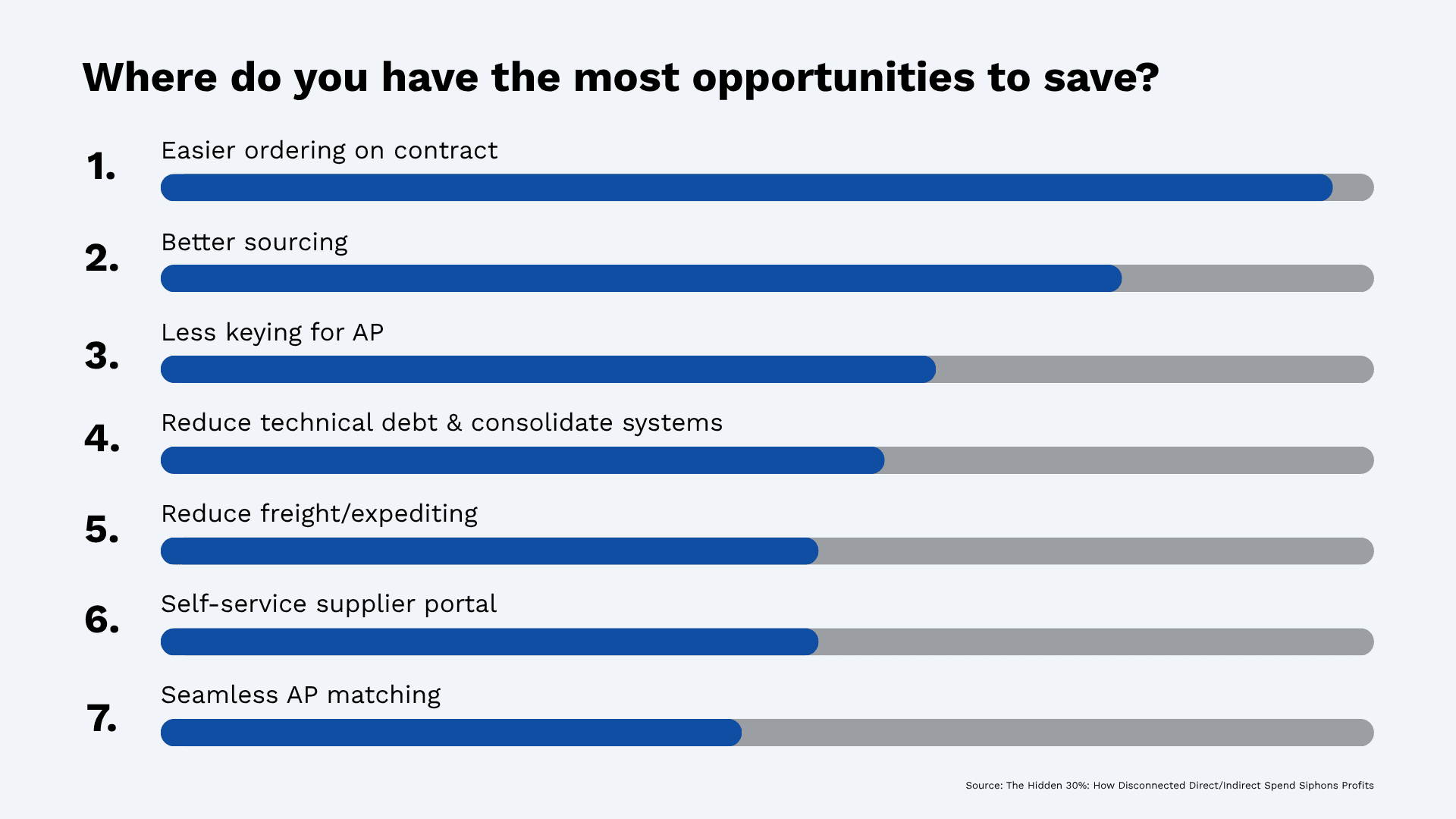
The Duplication Tax: Reclaiming Capital Trapped in Supplier Overlap
Supplier duplication is the hidden tax on procurement efficiency — costing organizations millions in lost leverage, redundant work, and unclaimed capital.
Read More

Off-contract purchasing, often called maverick spend, remains one of the most persistent challenges for procurement and finance teams. The term 'maverick' suggests rogue employees deliberately circumventing policy, but the behavioral reality tells a different story. For employees, it’s often the fastest way to get work done; for procurement, it’s a constant battle to enforce negotiated agreements and protect hard-won savings. Left unchecked, maverick spend can quietly erode millions in potential revenue equivalent — undermining savings, diluting supplier leverage, and creating costly inefficiencies across finance and operations.
During a recent webinar with Acquis and Coupa, procurement leaders zeroed in on one clear opportunity for organizational savings: make on-contract purchasing easier. Recent data confirms the scale of the problem: 35–75% of organizational spend still occurs outside negotiated contracts. The root cause of maverick spend isn't employee behavior — it's a lack of guided buying automation that forces productivity-minded workers to choose between getting work done and following procurement policy.

"People go rogue because they're trying to get their day done," explained Mark Schenecker, VP of Direct Materials at Coupa. "They need a material or service, and they just spend."
This pattern reflects a fundamental design flaw: procurement systems built with too much control create friction that drives efficiency-seeking employees toward workarounds. When marketing needs event supplies within 48 hours, a five-step approval process represents guaranteed personal cost (delayed project completion) while contract compliance offers abstract organizational benefits.
Tyson Moore, SVP of Procurement at Acquis, describes the simple, predictable result: "Spend follows the path of least resistance.”
The behavioral psychology is straightforward: employees migrate toward systems that reduce cognitive load and time investment. Complex approval workflows, a lack of understanding of broader contractual benefits, and fragmented systems create cognitive burdens that busy professionals naturally avoid. Traditional ERP systems compound this problem by prioritizing financial reporting over user experience, creating interfaces that feel punitive rather than helpful.
When individual employees bypass procurement systems, the organizational costs multiply in ways that traditional accounting doesn't capture. Each workaround creates downstream inefficiencies that compound across multiple business functions.
Organizations spend an average of $925 annually to manage each supplier relationship — a cost that multiplies when departments independently onboard duplicate vendors for identical or complimentary services. "We see this a lot across plants," Schenecker explained. "One plant will buy from '3M' and another from 'Minnesota Mining Manufacturing' — it's the same company, just named differently in the system."
This fragmentation destroys negotiation leverage as spend disperses across duplicate suppliers rather than consolidating for volume discounts. A $2M annual relationship, for example, becomes four separate $500K relationships with reduced bargaining power.
The hidden cost extends beyond direct financial impact to strategic capacity displacement. Finance teams spend time reconciling workarounds instead of analyzing business performance. Procurement professionals manage supplier proliferation rather than developing strategic relationships. The organization optimizes individual productivity at the expense of enterprise efficiency.
The solution requires aligning individual productivity incentives with organizational procurement strategy. Organizations achieving 75-90% on-contract spending do not simply enforce compliance through policy — they engineer it by making contracted purchasing faster and easier than alternatives.
The design principle is straightforward: make the right choice the easy choice. When contracted suppliers offer superior user experience compared to workaround alternatives, compliance becomes natural behavior rather than something requiring discipline or training.
This requires three fundamental capabilities working in concert:
Complete spend visibility aggregates data from ERP, finance systems, and departmental purchasing into a single view, eliminating the information fragmentation that forces employees to make purchasing decisions blind to organizational contracts and budget constraints
Automated consolidation logic identifies supplier duplication and negotiation opportunities invisible to individual departments, allowing procurement to optimize enterprise leverage without adding workflow steps for end users
Intelligent guidance systems surface preferred suppliers and pre-negotiated pricing automatically at the point of purchase, making contracted options the default choice rather than something requiring research or navigation
These capabilities work through procurement workflows that require fewer clicks than Amazon Business, consolidated contract terms and supplier catalogs accessible from a single system, and approval logic that accelerates routine purchases while maintaining oversight for exceptions. Real-time budget integration and intelligent exception handling eliminate the manual overhead that creates friction, reducing the $925 annual cost per supplier relationship while providing better visibility into purchasing patterns and budget performance.
Successful procurement transformation recognizes that user adoption depends on addressing legitimate productivity concerns while demonstrating immediate value improvements. Change management focuses on stakeholder experience rather than system features.
Involving business unit leaders in workflow design ensures solutions address real operational needs rather than theoretical compliance requirements. When departments participate in solution design, they become advocates for change rather than sources of resistance. This collaborative approach identifies practical implementation challenges that top-down mandates often miss.
Quick wins through improved purchasing experiences build momentum for broader transformation initiatives. Early successes prove that compliance enhancement doesn't require operational flexibility reduction, creating organizational confidence in centralized procurement approaches while establishing credibility for longer-term strategic changes.
Understanding resistance patterns allows for targeted support rather than organization-wide policy mandates. Departments resist change when new processes create operational difficulties without clear benefits. Addressing specific concerns through customized implementation approaches builds support for enterprise procurement strategies.
For mid-market organizations losing millions annually to maverick spend, the solution isn't more complex systems or stricter policies. It's recognizing that procurement compliance is a user experience problem requiring design solutions rather than behavioral control.
Total Spend Connect, co-developed by Acquis and Coupa, delivers exactly this approach — unifying spend visibility, automating supplier consolidation, and guiding users toward contracted purchasing through intuitive workflows and built-in change management. Organizations implementing this methodology achieve 96.4% pre-approved spend compliance and 81.1% on-contract spending not through enforcement, but by making the right choice the easy choice.
The choice between control and agility was always false. When procurement systems align individual productivity with organizational strategy, compliance becomes natural behavior rather than enforced discipline. The most efficient employees become your strongest procurement advocates because the system finally works the way they do.
Reach out to the Acquis team
Tags:

Supplier duplication is the hidden tax on procurement efficiency — costing organizations millions in lost leverage, redundant work, and unclaimed capital.
Read More

The most effective travel programs do not start with restrictions. They start with understanding employees’ travel habits and preferences, the organization’s business needs and objectives, and the technology capabilities that can guide behavior without requiring constant oversight.
Read More

Agentic AI changes how private equity firms approach post-merger integration (PMI). Yet, most remain stuck in the old paradigm, leaving significant value uncaptured.
Read More

Supplier duplication is the hidden tax on procurement efficiency — costing organizations millions in lost leverage, redundant work, and unclaimed capital.
Read More

The most effective travel programs do not start with restrictions. They start with understanding employees’ travel habits and preferences, the organization’s business needs and objectives, and the technology capabilities that can guide behavior without requiring constant oversight.
Read More

Agentic AI changes how private equity firms approach post-merger integration (PMI). Yet, most remain stuck in the old paradigm, leaving significant value uncaptured.
Read More